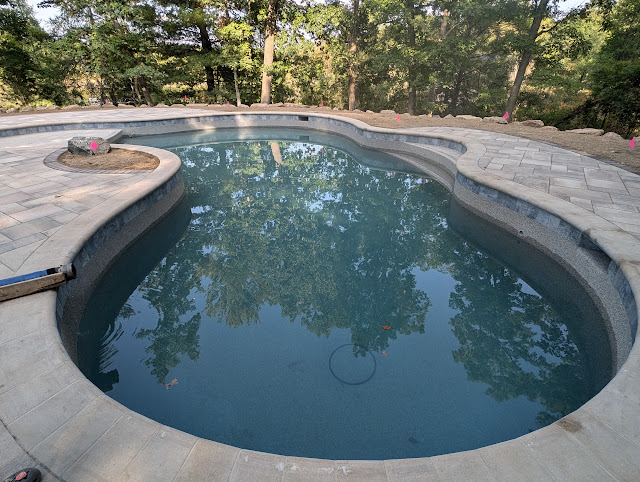Plaster day commenced bright and early on Tuesday and completed before lunch. The plaster crew was already setting up when I was getting the kids ready for school. They worked full tilt using two of our hose bibs for water supply and didn't stop until they were done. Tomorrow they'll return to power wash the surface to expose the aggregate and clean up loose plaster, then water will quickly follow around noon. It won't be long now until we're finally swimming.
I counted no less than eight guys on the plaster crew. One was manning the mixer and the rest were spreading and smoothing the plaster. They set up a guy line across the pool so their tool hoses could hang from them to prevent rubbing on the newly plastered finish. They laid plastic tarp over all the patio surfaces to prevent the plaster from adhering to the finished surface.
Here's the mixer for the plaster and the guy that was manning it. Three things went into the mixer tub at the top, something contained in bottles in that box, the white plaster bags, and the brown aggregate bags. After the contents mixed, it would swivel and dump into the hopper on the back, which pumped the mixture through the brown hose to the pool location. The mixing was super dusty, so he was wearing proper respiration PPE.
And here's the preliminary results. Remember, that tomorrow, they'll come back and power wash the surface, so the color will slightly change. I didn't step on it, but it's all smooth with curved transitions in all the bottom corners and step edges. The surface is incredibly uniform considering it was all done by hand.
Here's the shallow end and sun shelf. Note the flags around the pool. We had American Lawn Sprinkler come out yesterday to evaluate the damage and lay out the irrigation for the new planting beds. Luckily, there was very minimal damage. We'll be able to combine the two lawn loops onto one valve, and use the existing valve for the new bed irrigation loop. Pipe will still need to be excavated into the landscape, but at least we won't have to worry about adding another valve to the valve box.
Here's what the color looks like in the sun. There are still some wet areas and a dusting of plaster on the aggregate, and the actual color will vary with the depth of the water, but this area will be the most shallow and so, closes to the plaster color.
The close up of the plaster is very close to the color of the sample we initially obtained. This mixture, called
Tahoe Blue, has some glass pebbles for a little sparkle, but not as much as some of the other lines from
PebbleTec.
The plaster was brought up to the level of the tile, making it about half an inch thick. I'm not sure how they keep the thickness in areas not near a tile but they probably have some method. All the plaster is hard to the touch, but I haven't stepped on it yet. Although it will be washed tomorrow, I didn't want to risk contaminating or damaging the surface.
All the corners of the sunshelf and every step has a radius on it, making it very comfortable to sit or walk on. It will also help prevent chipping of the plaster. Speaking about durability, in the past, most pools were coated with only plaster, which provided a very smooth surface, but wasn't very durable. It was prone to chipping and flaking with age. This PebbleTec surface should provide improved durability because of the smooth stone aggregate. The stone is more resistant to damage, but since they're polished, should also feel nice on the skin. I think the most expensive, but durable, option would have been to tile the entire pool.
The pool finish continues into the bottom surface of the skimmer, sealing the concrete right up to the tile. This area will still be under a little water but might be exposed during the winter time when the water is drained down. I don't think exposing the plaster to air will damage it.
The plaster around the pool return fitting is a little rougher than the tiles, but I think there will be another jet that screws into the fitting to clean up the appearance.
The plaster work around the lights are also a little rougher, but not horrible looking. Maybe when they power wash happens, some of the plaster and aggregate on the light flange will clean off and make it look more circular. It's a minor thing though.
This temporary slough tank was constructed of plywood and tarp. I think it's used as a settling pond for the washed out liquid and plaster during the plastering process. It will probably be used to settle out the power washed plaster tomorrow as well. The water can be drained off and the tarp removed along with all the settled out plaster.
That's it for today. Tomorrow is the big day with the plaster being cleaned and water finally getting into the pool. I'm not sure if the filtration system will be up and running tomorrow, or Thursday, when a Jandy installer will come and set up the automation hardware. The gas inspection passed today so the gas line can be hooked up to the heater and we can get the water warmed up for swimming. The forecast predicts some 80F degree weather for the rest of the week, with next week being in the mid 70s, so we'll at least have some swimming weather before the end of the year.



















































